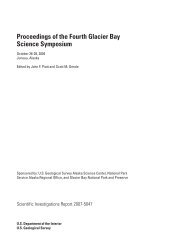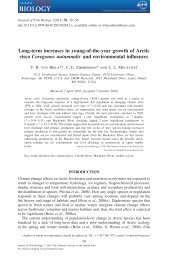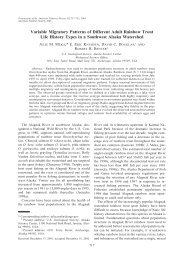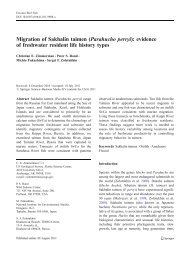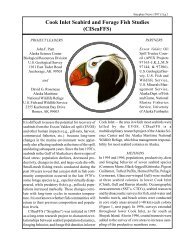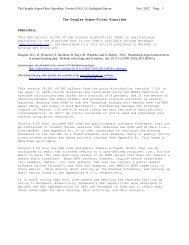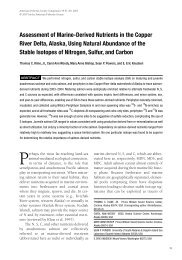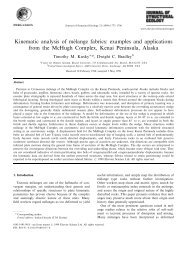Mexican native trouts: a review of their history and ... - Webspace
Mexican native trouts: a review of their history and ... - Webspace
Mexican native trouts: a review of their history and ... - Webspace
You also want an ePaper? Increase the reach of your titles
YUMPU automatically turns print PDFs into web optimized ePapers that Google loves.
274<br />
observations made between 1975 <strong>and</strong> 2000. We present newly discovered historical evidence that leads us to<br />
conclude that a “lost” cutthroat trout, a lineage not previously known from Mexico, was collected more than a<br />
century ago from headwaters <strong>of</strong> the Río Conchos (a major tributary <strong>of</strong> the Rio Gr<strong>and</strong>e (= Río Bravo)), a basin not<br />
previously considered to harbor a <strong>native</strong> trout. We <strong>review</strong> the last century <strong>of</strong> regional natural resource management<br />
<strong>and</strong> discuss our own observations <strong>of</strong> trout habitats. Impacts <strong>of</strong> logging, road building <strong>and</strong> overgrazing are<br />
widespread <strong>and</strong> exp<strong>and</strong>ing. Many streams suffer from heavy erosion, siltation <strong>and</strong> contamination, <strong>and</strong> though<br />
long-term hydrologic data are generally not available, there is evidence <strong>of</strong> decreased discharge in many streams.<br />
These problems appear related to region-wide l<strong>and</strong> management practices as well as recent regional drought. Trout<br />
culture operations using exotic rainbow trout have rapidly proliferated throughout the region, threatening genetic<br />
introgression <strong>and</strong>/or competition with <strong>native</strong> forms <strong>and</strong> predation on them. Knowledge <strong>of</strong> distribution, abundance,<br />
relationships <strong>and</strong> taxonomy, not to mention ecology <strong>and</strong> population biology, <strong>of</strong> <strong>native</strong> <strong>trouts</strong> <strong>of</strong> the Sierra Madre<br />
Occidental remains inadequate. Vast areas <strong>of</strong> most mainl<strong>and</strong> drainages are still unexplored by fish collectors, <strong>and</strong><br />
even rudimentary information regarding basic biology, ecology <strong>and</strong> population structure <strong>of</strong> stocks remains lacking.<br />
Concentrated exploration, research <strong>and</strong> management <strong>of</strong> this long overlooked <strong>and</strong> undervalued resource are all<br />
urgently needed. The <strong>history</strong> <strong>of</strong> natural resources exploitation that placed so many <strong>native</strong> <strong>trouts</strong> <strong>of</strong> the western<br />
United States on threatened <strong>and</strong> endangered species lists is repeating itself in the Sierra Madre Occidental. Without<br />
concerted action <strong>and</strong> development <strong>of</strong> region-wide socio-economic solutions for current, largely non-sustainable<br />
resource management practices, <strong>native</strong> <strong>Mexican</strong> trout gene pools will soon be in grave danger <strong>of</strong> extinction.<br />
Introduction<br />
Unambiguously <strong>native</strong> <strong>Mexican</strong> <strong>trouts</strong> range from near<br />
the U.S. border in Baja California <strong>and</strong> headwaters<br />
<strong>of</strong> mainl<strong>and</strong> Pacific drainages <strong>of</strong> the Sierra Madre<br />
Occidental from the Río Yaqui southward to at least<br />
the Río Culiacán (Needham <strong>and</strong> Gard, 1959), <strong>and</strong><br />
disputably <strong>native</strong> or introduced populations (Lindsey,<br />
1960; Miller, 1960; Miller <strong>and</strong> Smith, 1986; Minckley<br />
et al., 1986) extend further southward in mainl<strong>and</strong><br />
Pacific drainages to at least the Presidio <strong>and</strong> perhaps<br />
Baluarte <strong>and</strong> Acaponeta river drainages (Figure 1).<br />
Other possibly <strong>native</strong> populations occur in endorheic<br />
basins that are part <strong>of</strong> the Casas Gr<strong>and</strong>es or Guzmán<br />
system on the east side <strong>of</strong> the continental divide<br />
in Chihuahua (Behnke, 1992; Needham <strong>and</strong> Gard,<br />
1959) <strong>and</strong>, though voucher specimens are lacking,<br />
a trout may be <strong>native</strong> to the upper Río Conchos, a<br />
major tributary <strong>of</strong> the Rio Gr<strong>and</strong>e (Río Bravo), which<br />
drains eastward to the Gulf <strong>of</strong> Mexico. Nearly half a<br />
century has passed since these interesting fishes were<br />
comprehensively studied. In the interim, relatively<br />
few collections have been made <strong>and</strong> habitats have<br />
been altered in many ways. Logging has exp<strong>and</strong>ed<br />
considerably <strong>and</strong> continues to do so, with sawdust<br />
<strong>and</strong> other waste products <strong>of</strong>ten contaminating streams<br />
as well as contributing to increased erosion, siltation,<br />
flow variability <strong>and</strong> decreased stream shading. Non<strong>native</strong><br />
fishes have been widely introduced, including<br />
rainbow trout (Oncorhynchus mykiss) <strong>native</strong>tothe<br />
western United States, which many studies on other<br />
<strong>native</strong> <strong>trouts</strong> <strong>of</strong> the southwestern U.S. tell us will<br />
likely interbreed with <strong>native</strong> forms (Behnke, 1992;<br />
Behnke <strong>and</strong> Tomelleri, 2002; Carmichael et al., 1993;<br />
Carmichael et al., 1996; Dowling <strong>and</strong> Childs, 1992;<br />
Leopold, 1918; Propst et al., 1992; U.S. Fish <strong>and</strong><br />
Wildlife Service, 1987), have been widely introduced.<br />
The construction <strong>of</strong> small hatcheries <strong>and</strong><br />
growout facilities for this non-<strong>native</strong> continues to<br />
exp<strong>and</strong> rapidly throughout the region. In general,<br />
many lines <strong>of</strong> evidence indicate that trout habitats in<br />
the Sierra Madre Occidental are more geographically<br />
restricted than they were when Needham <strong>and</strong> Gard<br />
<strong>and</strong> <strong>their</strong> colleagues sampled <strong>and</strong> there is no indication<br />
that habitat conditions will improve in the near<br />
future. Much <strong>of</strong> the historic range <strong>of</strong> <strong>Mexican</strong> <strong>native</strong><br />
<strong>trouts</strong> remains unsampled <strong>and</strong> several taxa remain<br />
undescribed. Knowledge <strong>of</strong> these fascinating, littlestudied,<br />
<strong>and</strong> potentially valuable fishes remains inadequate<br />
to allow managers to make sound management<br />
decisions, or even to simply assess conservation status<br />
<strong>of</strong> the various taxa <strong>and</strong> populations. These relatively<br />
unstudied <strong>trouts</strong> should probably all be considered<br />
threatened or endangered, yet, surely as a result <strong>of</strong><br />
lack <strong>of</strong> information <strong>and</strong> formal taxonomic description,<br />
only two <strong>of</strong> them, the <strong>Mexican</strong> golden trout (Oncorhynchus<br />
chrysogaster) <strong>and</strong> Baja California rainbow<br />
trout (O. mykiss nelsoni – also sometimes called<br />
Nelson’s trout), have been included in major lists <strong>of</strong><br />
government or international agencies. <strong>Mexican</strong> golden<br />
trout has been listed by the <strong>Mexican</strong> Government<br />
as threatened (“amenazada”) (Secretaría de Desar-




